Hydroelectric Power
Hydroelectric Power
Hydro-electric power, using the potential energy of rivers, now supplies 17.5% of the world's electricity (99% in Norway, 57% in Canada, 55% in Switzerland, 40% in Sweden, 7% in USA). Apart from a few countries with an abundance of it, hydro capacity is normally applied to peak-load demand, because it is so readily stopped and started. It is not a major option for the future in the developed countries because most major sites in these countries having potential for harnessing gravity in this way are either being exploited already or are unavailable for other reasons such as environmental considerations. Growth to 2030 is expected mostly in China and Latin America.
Hydro energy is available in many forms, potential energy from high heads of water retained in dams, kinetic energy from current flow in rivers and tidal barrages, and kinetic energy also from the movement of waves on relatively static water masses. Many ingenious ways have been developed for harnessing this energy but most involve directing the water flow through a turbine to generate electricity. Those that don't usually involve using the movement of the water to drive some other form of hydraulic or pneumatic mechanism to perform the same task.
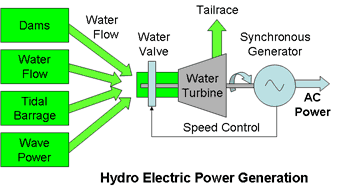
Water Turbines
Like steam turbines, water turbines may depend on the impulse of the working fluid on the turbine blades or the reaction between the working fluid and the blades to turn the turbine shaft which in turn drives the generator. Several different families of turbines have been developed to optimise performance for particular water supply conditions.
Turbine Power Output
In general, the turbine converts the kinetic energy of the working fluid, in this case water, into rotational motion of the turbine shaft.
Swiss mathematician Leonhard Euler showed in 1754 that the torque on the shaft is equal to the change in angular momentum of the water flow as it is deflected by the turbine blades and the power generated is equal to the torque on the shaft multiplied by the rotational speed of the shaft. See following diagram.
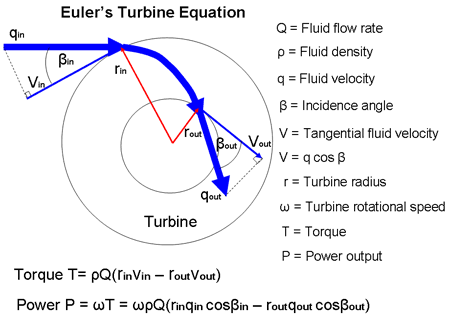
Note that this result does not depend on the turbine configuration or what happens inside the turbine. All that matters is the change in angular momentum of the fluid between the turbine's input and output.
Hydroelectric Power Generation Efficiency
Hydroelectric power generation is by far the most efficient method of large scale electric power generation. See Comparison Chart. Energy flows are concentrated and can be controlled. The conversion process captures kinetic energy and converts it directly into electric energy. There are no inefficient intermediate thermodynamic or chemical processes and no heat losses.
The conversion efficiency of a hydroelectric power plant depends mainly on the type of water turbine employed and can be as high as 95% for large installations. Smaller plants with output powers less than 5 MW may have efficiencies between 80 and 85 %.
It is however difficult to extract power from low flow rates.
Turbine Types
The most appropriate turbine to use depends on the rate of water flow and the head or pressure of water.
- Pelton Turbine
- Francis Reaction Turbine
- Propeller and Kaplan Turbines
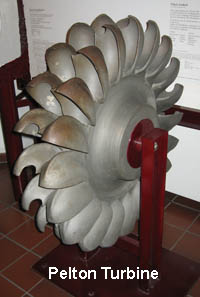 | The Pelton turbine is an impulse turbine.It requires tangential water flow on one side of the wheel and must therefore operate when only partly submerged. It is best suited to applications with a high head but a low volume flow rate such as fast flowing shallow water courses though it is used in a wide range of situations with heads from as low as 15 metres up to almost 2000 metres. High pressure heads give rise to very fast water jets impinging in the blades resulting in very high rotational speeds of the turbine. Pelton wheels are ideal for low power installations with outputs of 10kW or less but they have also been used in installations with power outputs of up to 200 MW. Efficiencies up to 95% are possible. |
|---|
The Francis turbine is a reaction turbine designed to operate fully submerged. Water flow enters in a radial direction towards the axis and exits in the direction of the axis. Its is suitable for lower heads of water of 500 metres or less and is the most commonly used high power turbines. Large scale turbines used in dams are capable of delivering over 500 MW of power from a head of water of around 100 metres with efficiencies of up to 95% | 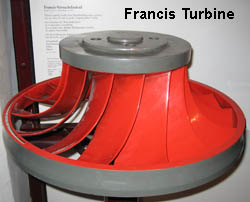 |
|---|
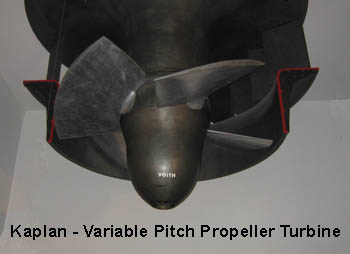 | The propeller turbine, is another example of a reaction turbine. Designed to work fully submerged, it is similar in form to a ship's propeller and is the most suitable design for low head water sources with a high flow rate such as those in slow running rivers. Designs are optimised for a particular flow rate and efficiencies drop of rapidly if the flow rate falls below the design rating. The Kaplan version has variable pitch vanes to enable it to work efficiently over a range of flow rates. |
|---|
Power from Dams (Potential Energy)
- Supply CharacteristicsA hydroelectric dam installation uses the potential energy of the water retained in the dam to drive a water turbine which in turn drives an electric generator. The available energy therefore depends on the head of the water above the turbine and the volume of water flowing through it. Turbines are usually reaction types whose blades are fully submerged in the water flow.The diagram opposite shows a typical turbine and generator configuration as used in a dam.
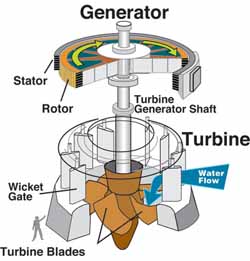 Source U.S. Army Corps of Engineers
Source U.S. Army Corps of Engineers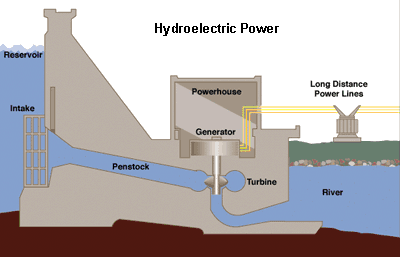 Source: TVAThe civil works involved in providing hydro-power from a dam will usually be many times the cost of the turbines and the associated electricity generating equipment. Dams however provide a large water reservoir from which the flow of water, and hence the power output of the generator, can be controlled. The reservoir also serves as a supply buffer storing excess water during rainy periods and releasing it during dry spells.
Source: TVAThe civil works involved in providing hydro-power from a dam will usually be many times the cost of the turbines and the associated electricity generating equipment. Dams however provide a large water reservoir from which the flow of water, and hence the power output of the generator, can be controlled. The reservoir also serves as a supply buffer storing excess water during rainy periods and releasing it during dry spells.
The build up of silt behind the dam can cause maintenance problems. - Available Power
Potential energy per unit volume = ρgh
Where ρ is he density of the water (103 Kg/m3 ), h is the head of water and g is the gravitational constant (10 m/sec2)
The power P from a dam is given by
P = ηρghQ
Where Q is the volume of water flowing per second (the flow rate in m3/second) and η is the efficiency of the turbine.
For water flowing at one cubic metre per second from a head of one metre, the power generated is equivalent to 10 kW assuming an energy conversion efficiency of 100% or just over 9 kW with a turbine efficiency of between 90% and 95%.
"Run of River" Power (Kinetic Energy)
- Supply Characteristics
- Available Power
"Run of river" installations are typically used for smaller schemes generating less than 10 MegaWatts output. Water from a fast flowing river or stream is diverted through a turbine, often a Pelton wheel which drives the electrical generator. The head of water is essentially zero and the turbine converts the kinetic energy of the flowing water into the rotational energy of the turbine and the generator. The available energy therefore depends on the quantity of water flowing through the turbine and the square of its velocity. Impulse turbines which are only partially submerged are more commonly employed in fast flowing run of river installations while In deeper, slower flowing rivers, submerged Kaplan turbines may be used to extract the energy from the water flow.
Run of river projects are much less costly than dams because of the simpler civil works requirements. They are however susceptible to variations in the rainfall or water flow which reduce or even cut off potential power output during periods of drought. During flood conditions the installation may not be able to accommodate the higher flow rates and water must be diverted around the turbine losing the potential generating capacity of the increased water flow. Because of these limitations, if the construction of a dam is not possible, run of river installations may need to incorporate some form of supply back-up such as battery storage, emergency generators or even a grid connection. See Capturing Renewable Energy for more details on back-up options.
The maximum power output from a turbine used in a run of river application is equal to the kinetic energy of the water impinging on the blades. Taking the efficiency η of the turbine and its installation into account, the maximum output power Pmax is given by
Pmax =½ηρQv2
where v is the velocity of the water flow and Q is the volume of water flowing through the turbine per second.
Q is given by
Q = A v
where A is the swept area of the turbine blades.
Thus
Pmax =½ηρAv3
This relationship also applies to shrouded turbines used to capture the energy of tidal flows (see below) and is directly analogous to the equation for the theoretical power generated by wind turbines. Note that the power output is proportional to the cube of the velocity of the water.
Thus the power generated by one cubic metre of water flowing at one metre per second through a turbine with 100% efficiency will be 0.5 kW or slightly less taking into account the inefficacies in the system. This is only one twentieth of the power generated by the same volume flow from the dam above. To generate the same power with the same volume of water from a run of river installation the speed of the water flow should be √20 metres per second (4.5 m/sec).
Tidal Power
- Supply Characteristics
- Available Power
Harnessing the power of the tides can be achieved by placing bi-directional turbines in the path of the tidal water flow in bays and river estuaries. To be viable, it needs a large tidal range and involves creating a barrier across the bay or estuary to funnel the water through the turbines as the tide comes in and goes out. Although tidal energy captured in tidal ponds have been used since Roman times to power mills, there are few modern installations. The first plant to utilise tidal energy on a large scale for electricity generation was built at Rance in France in1966. Others followed in Canada and Russia.
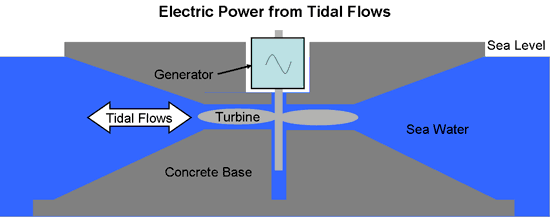
Tidal power comes closest of all the intermittent renewable sources to being able to provide an unlimited, continuous and predictable power output but unfortunately there are few suitable sites in the world and environmental constraints have so far prevented their general acceptance.
Shrouded water turbines placed in deep water tidal currents show better potential for exploitation, though the associated civil works are more complicated, and several projects are under development.
Power is available for only six to twelve hours per day depending on the ebb and flow of the tides.
The maximum power output from a shrouded water turbine used in tidal energy applications is equal to the kinetic energy of the water impinging on the blades, similar to the "run of river" calculation above. Taking the efficiency η of the turbine and its installation into account, the maximum output power Pmax is given by
Pmax =½ηρAv3
where v is the velocity of the water flow and A is the swept area of the blades.
A turbine one metre in diameter with a water current of one metre per second flowing through it would generate 0.4 kW of electricity assuming 100% efficiency. Similarly a 3 meter diameter turbine with a water current of 3 metres per second would produce 32 Kw of power.
Wave Power
- Supply Characteristics
- Energy Conversion Systems
- Oscillating Float System
- Hydraulic systems in which air is compressed in a pneumatic reservoir above the float during its upward movement on the crests of the waves. After the crests have passed, the air expands and forces the float downwards into the following troughs of the waves. A hydraulic system then uses the reciprocating movement of the float to pump water through a water turbine which drives a rotary electrical generator..
- Pneumatic systems in which the air displaced in the cylinder is used to power an air turbine which drives the generator.
- Linear generators to turn the reciprocating motion of the float directly into electrical power.
- Instead of generating the electricity on board the buoy, some systems pump the hydraulic fluid ashore to power shore based generators.
- Oscillating Paddle System
- Oscillating Snake System
- Oscillating Water Column
- Pressure Transducer System
- Wave Capture Systems
- Overtopping Wave Systems
- Lever Systems
- Technical Challenges
- Variability of the sea conditions
- Matching the generating equipment the wave characteristics
- Equipment construction
- Housing and mooring the equipment
- Energy transmission
- Resistance to storm damage
- Available Power
The energy available from the ocean's surface wave motion is almost in limited, but it has proved frustratingly difficult to capture. Many ingenious systems have been proposed but, except for very small installations, very few are generating electricity commercially and most have been thwarted by practical problems.
Some of these proposals are outlined below. Most are still in an experimental phase and many are not scalable into high capacity systems.
One of the simplest and most common solutions is the oscillating float system in which a float is housed inside an cylinder shaped buoy which is open at the bottom and moored to the seabed. Inside the cylinder the float moves up and down on the surface of the waves as they pass through the buoy.
Various methods have been employed to turn the motion of the float into electrical energy. These include:-
This system uses large paddles moored to the ocean floor to mimic the swaying motion of sea plants in the presence of ocean waves. The paddles are fixed to special hinged joints at the base which use the swaying motion of the paddles to pump water through a turbine generator.
The snake system uses a series of floating cylindrical sections linked by hinged joints. The floating snake is tethered to the sea bed and maintains a position head on into the waves. The wave-induced motion at the hinges is used to pump high-pressure oil through hydraulic motors via smoothing accumulators. The hydraulic motors in turn drive electrical generators to produce the electrical power.
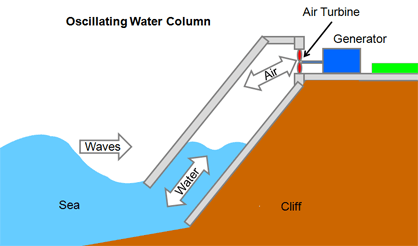
Water columns are formed within large concrete structures built on the shore line or on rafts. The structure is open at both the top and the bottom. The lower end is submerged in the sea and an air turbine fills the aperture at the top. The rising and falling of the water column inside the structure moves the air column above it driving the air through the turbine generator. The turbine has movable vanes which rotate to maintain unidirectional rotation when the movement of the air column reverses.
The hydraulic pump system uses a submerged gas-filled tank with rigid sides and base and a flexible, bellows-like, top. The gas in the tank compresses and expands in response to pressure changes from the waves passing overhead causing the top to rise and fall. A lever attached to centre of the top drives pistons, which pump pressurized water ashore for driving hydraulic generators.
Wave capture systems use a narrowing ramp to funnel waves into an elevated reservoir. Waves entering the funnel over a wide front are concentrated into a narrowing channel which causes the amplitude of the wave to increase. The increased wave height coupled with the momentum of the water is sufficient to raise a quantity of water up a ramp and into a reservoir situated above the sea level. Water form the reservoir can then be released through a hydroelectric turbine located below the reservoir to generate electricity. | 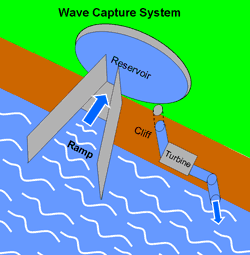 |
These are floating systems similar to the land based system described above. They focus waves onto a tapered ramp which causes their amplitude to increase. The crests of the waves overtop the ramp and spill into a low dam. Water from the low dam then flows through hydroelectric turbines back into into the sea beneath the floating structure.
Various lever based energy capture systems have been developed. Long levers may be mounted on steel piles or on floating platforms. Large floats or buoys are attached to the extremities of the levers which move up and down with the waves.
Movement of the lever arms forces fluid into a central hydraulic accumulator and through to a generator turbine. Alternatively high-pressure water can be pumped ashore to power shore based generators.
Formidable technical challenges are involved in designing practical systems for capturing wave energy.
Sea conditions are notoriously variable and the system must be able to cope with a wide range of wave amplitudes and frequencies as well as changes in the directions of currents.
Mechanisms are required to convert the power of the irregular oscillating mechanical forces induced by the waves into electrical power synchronised with the grid. This could involve some expensive power electronics.
Typical rotating machines used for power generation operate at a synchronous speed of 1200 r.p.m. (20 revolutions per second) whereas the frequency of waves driving the generator is likely to be between 5 and 10 seconds per cycle. A mechanical gearing system is needed to match this 200:1 ratio in operating speeds, possibly combined with special purpose, slow speed generators, incorporating a large number of pole pairs.
One way around all of these problems is to use hydraulic accumulators either in situ or on shore to smooth out the energy delivery to the generator.
For reasonable sized systems, very high mechanical forces will be involved converting the wave energy into mechanical energy for driving the electrical generator.
Substantial housings must be provided to protect the generating equipment from the harsh environment.
Holding the installation in place is also particularly difficult in deep water.
Low loss armoured and insulated cables or high pressure pipes must be developed for delivering the electrical or hydraulic energy back to the shore.
Storm damage is a major threat. The frequency of occurrence of waves of any particular amplitude follows a Rayleigh distribution similar to that which applies to wind speeds. Though the frequency of serious storms may be rather small, a wave of ten times the average amplitude may be expected once every 50 years. From the power calculation below, the wave power is proportional to the square of the wave amplitude. This means that the installation must be designed to withstand forces one hundred times greater than the normal working level. This adds considerably to the costs.
The wave power per unit length of the wave front PL is given by (Twiddel & Weir. Renewable Energy Resources) as
PL =ρga2λ/4T
Where ρ is he density of the water (103 Kg/m3 ), a is the wave amplitude (half of the wave height), g is the gravitational constant (10 m/sec2), λ is the wave length of the oscillation and T the period of the wave.
Thus for a wave with amplitude 1.5 metres, length 100 metres and period 5 seconds, the power per metre of wavefront will be 75 kW.
Ocean Thermal Energy
The boundless thermal energy of the warmer oceans of the world can also be used to generate electricity in much the same way as geothermal heat is used for electrical energy generation. Unfortunately conversion efficiencies are very low and economic viability is difficult to justify with current energy prices. The process and potential are described in more detail in the section on Ocean Thermal Energy Conversion (OTEC) on the Geothermal Energy pages.
See also Generators
Return to Electrical Energy Supply Overview
- How A Wind Turbine Works
Let's Take A Look At How A Wind Turbine WorksThe easiest way to understand how a wind turbine works is to think of a fan operating in reverse.So instead of electricity spinning the blades to generate wind, the wind spins the blades to generate electricity!A...
- Ocean Energy
What is Ocean Energy? All type of renewable energy which is acquired from the sea is called Ocean Energy. Constant flow of ocean currents contains huge amount of water across the earth's ocean. Technological development contributes to extract...
- Hydroelectric Power
What is Hydroelectric Power? Hydroelectric power is the technology of converting the kinetic energy of flowing or falling water into electrical energy. How does it work? A dam is constructed where there is a big river or a natural lake in a valley. Water...
- How Tidal Works?
When water levels are high in oceans and tides are producing and rushing to and fro, it has potential to produce electricity out of it. For producing electricity out of such wild potential oceans barrage is installed arou nd the corner of river, then...
- How Wind Turbines Work!!!
Wind ENERGYHow Wind Turbines Work!!! -Wind is a form of solar energy. Winds are caused by the uneven heating of the atmosphere by the sun, the irregularities of the earth's surface, and rotation of the earth. Wind flow patterns are modified by the...
